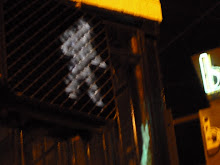Uluru/Ayers Rock

Alby, our guide for the “Just the Centre” part of the trip was … well, he was a lot of things. But what I appreciated most was his ability to explain the complexity of the relationship between Aboriginals and the dominant Australian culture. Obviously, just as explaining the relationship between the American government/culture and Native Americans is complicated and elusive, so is this similar situation in Australia. But Alby did his best to help us wrap our head and hearts around the questions that are out there ... and this made the experience so much richer, largely because of the confusion I felt.
One of the first things I noticed on the bus ride in from the Alice Springs airport was the large number of black people (obviously Aboriginals) walking around barefoot, with and awful clothes (worse than what homeless people wear in the US). They did look clean, and some of them appeared to be part of the city’s life, but they were obviously a separate, second (or lower) class of citizen … largely ignored (?), pitied (?), and not included in day-to-day living by the dominant culture. Apparently, it can be even worse in large cities, where drugs and violence become more of a problem. Racism is still pretty strong in Seattle, but this was a shock … it looked a lot like what I imagine the US was like before the Civil Rights movement. It sounds like there are hard feelings on both sides, and for good reasons on both sides.
The closer we got to Uluru and the other sights in the Centre, most of which are sacred people for the Aboriginal people, the more confusing the situation became for my heart. At one of the stops along the way, one of the pub owners explained his family’s history in pioneering tourism in the Outback. What I hadn’t realized is how recently people started traveling to the places we were going. The first tours happened in the late 1950s and early 1960s, and the large resorts and national parks we see today are very recent additions. When you consider that it took a while for the indigenous people to realize what was going on and how much it would encroach on their lifestyle (still the traditional lifestyle they’d been living for thousands of years), and then even longer to figure out how to communicate to the “white fella” what they felt about tourists coming to their sacred places and taking over their hunting lands … you start to realize the depth of the problems. And this is just the beginning of the issue.
According to Alby, the Australian government’s policy currently is to discover how the indigenous Aboriginal people want to live and understand their culture, with the ultimate goal being to have two very different cultures … Aboriginal and white … living side by side, understanding, respecting, and appreciating each other. I don’t know how much I believe that’s possible … or if I even think it’s a good thing. The two cultures obviously and unavoidably influence each other. It brings Star Trek to mind: is it possible to “leave no trace” as the Prime Directive instructs? Is it desireable?

All this was running through my head as we pulled up to Uluru. Add to that the beauty and unexpected intricate details of the monolith (caves, evidence of wind and water, boulders at the foot of the rock), and I was overwhelmed by the power of the place.
God will have to have His hand on this place (and the whole country) for this to get sorted out. It’s so much bigger than I can wrap my head around, and I’d guess the same would be true for the majority of people.
The other sites were not as emotionally overwhelming, but were stunning in their own right. I’d guess this is because there are fewer tourists at the less marketed sites, and fewer restrictions on where you can be and what you can do. Being able to explore King’s Canyon, to enjoy the colors and hike around on the tops of the cliffs was an incredible experience!


0 Comments:
Post a Comment
<< Home